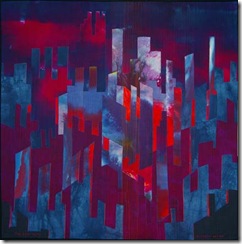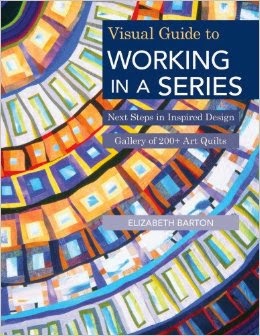I often wonder what pieces to enter into a show and why the jurors choose the ones they do (if they do!). When considering which pieces to enter, I try to remember what kind of work that particular show seems to favour. If there’s a catalogue, this may be indicated in the juror’s statement from the previous show.
In general juror’s statements are extremely useful to “mine” for ways to evaluate your work and to help you decide what to enter. You tend to see the same themes over and over: unity and harmony – everything playing together to “support the aesthetic statement”. So, I guess, if you want to make a quilt about “rough” – then your lines and shapes and colors and stitching etc should all be “rough” but also be sufficiently integrated to show a high level of craftsmanship – not so easy! And if your quilt is about “smooth” and all the elements are smooth then you run the risk of it being trite, banal, predictable and, of course, redundant! to say the least!
Another oft mentioned phenomenon sought by the average jurors is the grabbing of their attention. Does the image compel them to want to look longer and further and become lost in the piece? but then what happens to the subtle quietly beautiful piece? probably lost in the crowd…alas.
One juror remarked that it was hard not to favor innovation over adaptation, i.e. work in a series – but not for too long! Freshness, originality, innovation are the concepts of which most jurors are very fond. I notice that in the local art shows I like to enter these are the key ideas which the juror say he/she seeks. Though sometimes it is hard to see! For example in the recent OCAF (Oconee County Art Federation), the juror picked 2 of the following three pieces:
She chose the two more complex subtle pieces rather than the bold strong graphic quilt, which surprised me, so one should be bold and innovative, but not too bold or innovative!
Quilt National, the grand master of all quilt shows (or should that be mistress?), has been said to be a “standard bearer for change, advocating innovation and [presenting] a challenge to redefine the concept of quilt” (Robin Treen, QN 2007).
To make a quilt that meets these requirments is a huge challenge for those of us still attempting to master this very complex medium that requires considerable technical skills as well as a thorough knowledge of composition and design – and on top of that the requirement to be always forward-looking, breaking fresh ground, leaping upward without a nice comfortable crampon or two! And very often I feel that those who have mastered the medium then find it hard to be yet more innovative, introduce more and newer ideas.
On the above occasion the simpler bolder piece was the one that was picked. Hmm…
but then this piece was rejected:
and the one below (which is okay, but definitely not as strong as the one on the right) was accepted…
Well with the upcoming shows, I shall try to be innovative, but not too much so, bold and subtle, obvious and obscure. I wonder if I dare to enter my unrecyclable piece anywhere?
I’m sure those quilt police would just love the ratty old towel upon which this piece is based…but arn’t those dye splotched towels we have in our dye studios so beautiful? and they are truly innovative…you don’t see them anywhere else…..hmm…..
well, if you have been, thanks for reading! and do let me know your thoughts, especially if they run counter to mine! I’m interested in all ideas….especially, of course, the innovative ones!! Elizabeth






























